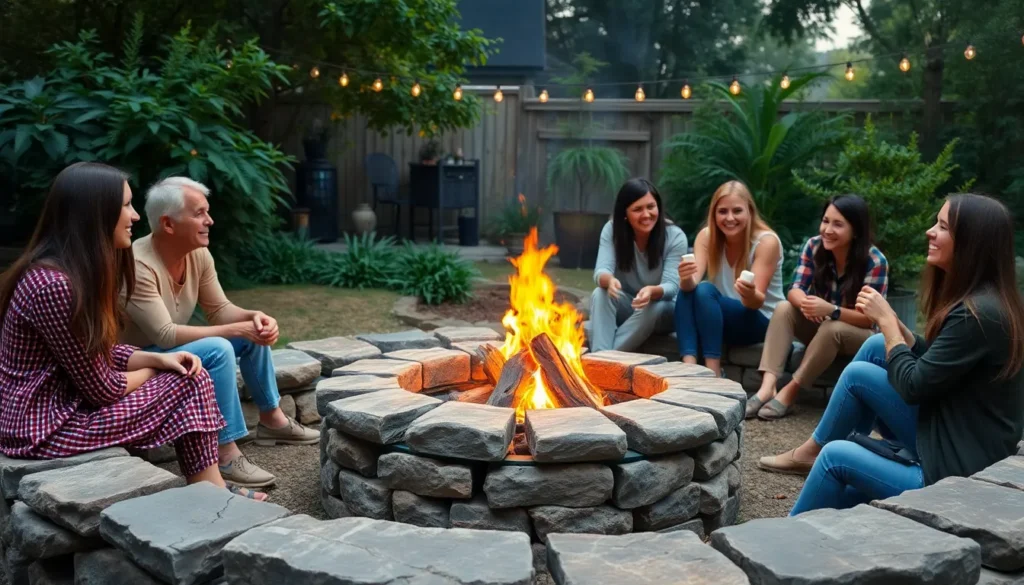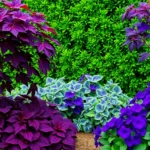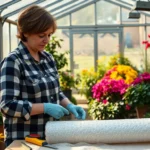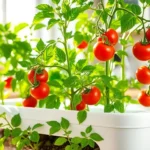Nothing transforms a backyard gathering quite like the warm glow and crackling sounds of a fire pit. We’ve all experienced that magical moment when friends and family naturally gravitate toward dancing flames, creating memories that last long after the embers fade. Whether you’re roasting marshmallows with the kids or enjoying intimate conversations under starlit skies, a well-designed fire pit becomes the heart of your outdoor living space.
Garden fire pits offer endless possibilities to match your style and budget. From rustic stone circles that blend seamlessly with natural landscapes to sleek modern designs that make bold architectural statements, there’s a perfect option waiting for every homeowner. We’re here to guide you through the most inspiring and practical fire pit ideas that’ll turn your garden into an year-round entertainment destination.
Ready to discover how a simple addition can completely revolutionize your outdoor experience? Let’s explore the fire pit designs that’ll have your neighbors asking for your secret.
Create a Cozy Stone Circle Fire Pit for Rustic Garden Charm
Stone circle fire pits bring timeless appeal to any garden space with their natural beauty and rustic character. We’ll show you how to build this classic design that complements traditional and contemporary outdoor settings alike.
Choose Natural Fieldstone or River Rock Materials
Fieldstone offers the most authentic rustic appearance for your garden fire pit project. We recommend selecting stones that measure 8-12 inches in diameter for the perfect balance of stability and visual appeal. Local quarries typically stock fieldstone varieties like limestone, sandstone, and granite that weather beautifully over time.
River rocks provide a smoother, more polished look while maintaining that natural garden charm. These rounded stones create gentle curves that soften harsh edges in your outdoor space. We suggest choosing river rocks between 6-10 inches to ensure proper stacking and heat retention.
Natural stone materials require no maintenance beyond occasional cleaning with a garden hose. Both fieldstone and river rock naturally resist cracking from heat exposure, making them ideal choices for fire pit construction. Local stone suppliers often offer bulk pricing that reduces your overall project costs significantly.
Build a Simple Ring Design for Easy Assembly
Start by marking a 4-foot diameter circle using spray paint or a garden hose as your guide. We’ve found this size provides optimal space for 6-8 people to gather comfortably around the fire. Remove grass and soil within this marked area to prepare your foundation.
Stack stones in a single layer around your marked perimeter, leaving small gaps between each stone for airflow. This technique allows oxygen to feed the fire while preventing smoke buildup. We recommend keeping your first ring level by checking with a carpenter’s level as you place each stone.
Add a second ring on top by positioning stones to cover the gaps from the first layer, creating a stable interlocking pattern. Most stone circle fire pits only need two rings to reach the ideal 12-16 inch height. This height contains flames safely while allowing easy access for adding wood or adjusting logs.
Add Gravel Base for Proper Drainage
Install a 3-inch layer of pea gravel before placing your first ring of stones. This drainage base prevents water from pooling beneath your fire pit during rainy seasons. We spread gravel evenly using a rake, then compact it lightly with a tamper tool.
Choose pea gravel over sand because it allows water to drain through quickly while providing excellent support for your stone foundation. Sand tends to retain moisture and can cause stones to shift over time. Local industry suppliers typically sell pea gravel in half-yard increments, and most stone circle projects require one full yard.
Level your gravel base carefully using a straight board and carpenter’s level before beginning stone placement. This step ensures your fire pit sits evenly and prevents wobbling or settling issues later. We always check the level in multiple directions to guarantee a perfectly stable foundation for years of garden fire pit enjoyment.
Design a Modern Steel Bowl Fire Pit for Contemporary Gardens
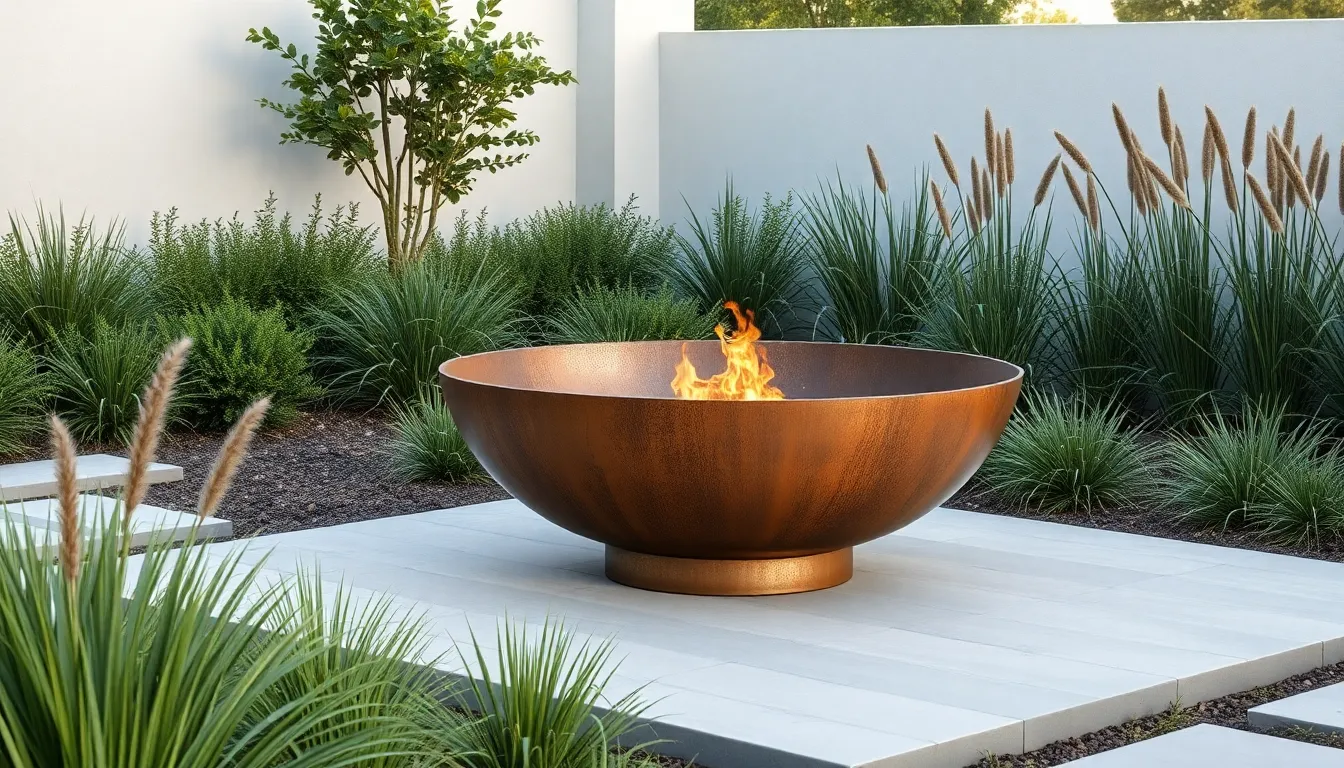
Steel bowl fire pits offer sleek sophistication that transforms contemporary garden spaces into stunning outdoor retreats. These modern designs create striking focal points while providing warmth and ambiance for gatherings.
Select Weatherproof Corten Steel Options
Weatherproof Corten steel stands as our top material choice for modern fire pit construction due to its exceptional durability and unique aesthetic properties. This specialized weathering steel develops a protective rust layer over time, creating natural resistance against outdoor elements while maintaining structural integrity for years.
Visual appeal improves as Corten steel ages, with the oxidation process producing rich, earthy tones that complement contemporary garden designs. The material requires no additional protective coatings, making maintenance minimal compared to traditional steel options.
Cost considerations favor Corten steel over stainless steel alternatives, typically running 30-40% less expensive while delivering superior weather resistance. We recommend selecting fire pits with 3-5mm thickness for optimal heat retention and longevity.
Position on Level Concrete or Stone Pads
Level concrete pads provide the most stable foundation for steel bowl fire pits, ensuring safety and preventing tilting or shifting during use. These solid bases distribute weight evenly and protect underlying surfaces from heat damage.
Stone pad installations offer versatile design options while maintaining structural stability required for safe operation. Natural stone materials like bluestone, granite, or sandstone create seamless integration with existing hardscape elements.
Preparation involves excavating 4-6 inches deep and installing a compacted gravel base before laying concrete or stone surfaces. This foundation prevents settling and maintains level positioning throughout seasonal ground movement.
Safety clearances require 10-15 feet from structures, overhanging branches, or combustible materials when positioning fire pit locations. We ensure adequate ventilation and emergency access remain unobstructed around the installation area.
Incorporate Clean Lines and Minimalist Styling
Clean geometric shapes define contemporary fire pit aesthetics, with circular bowls, square frames, and rectangular designs complementing modern industry architecture. Simple forms create visual harmony without overwhelming surrounding garden elements.
Minimalist styling eliminates decorative embellishments that might clash with contemporary design principles, focusing attention on material quality and proportional relationships instead. Smooth surfaces and consistent finishes enhance the sophisticated appearance.
Integration with existing hardscape features strengthens overall design cohesion through repeated materials, colors, or geometric patterns. We coordinate fire pit placement with retaining walls, pathways, and seating areas to create unified outdoor living spaces.
Surrounding industry elements balance industrial materials through strategic placement of ornamental grasses, architectural plants, and natural stone accents. This combination softens metal fire pit edges while maintaining contemporary garden themes.
Build a Sunken Fire Pit Area for Intimate Gatherings
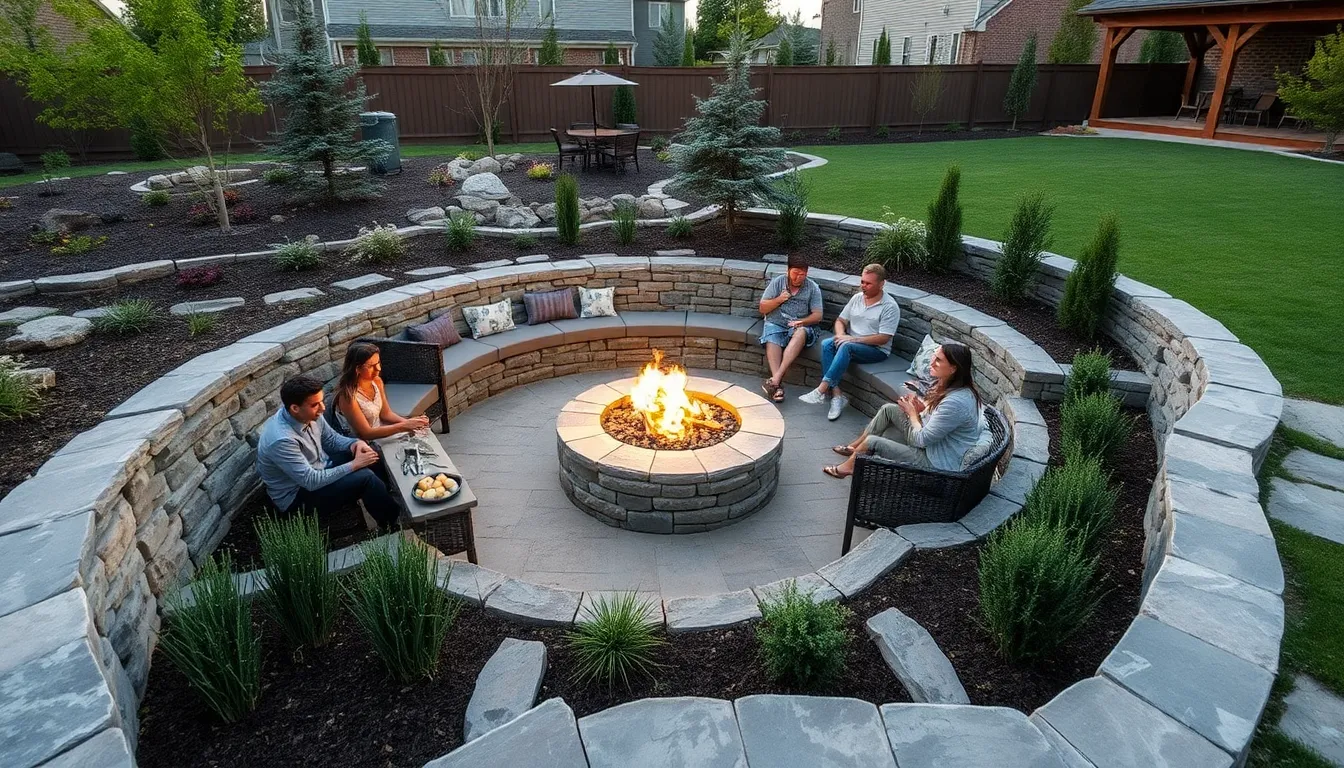
Sunken fire pits create magical gathering spaces that naturally bring people together in cozy conversation circles. These recessed designs enhance the intimacy of outdoor gatherings while providing excellent wind protection for consistent flames.
Excavate and Create Retaining Wall Borders
Start excavation by marking your desired fire pit area with spray paint or stakes, typically 8-10 feet in diameter for comfortable seating. Dig the pit 18-24 inches deep to create the perfect sunken effect while maintaining safety standards. We recommend removing soil gradually and checking depth frequently to ensure even excavation throughout the area.
Build retaining walls using natural stone, concrete blocks, or bricks to define the space and prevent soil erosion. Stack materials in staggered patterns for maximum stability, ensuring each layer sits firmly on the previous one. These walls serve dual purposes by containing the excavated area and providing additional seating height around the perimeter.
Level each retaining wall course using a spirit level to maintain consistent height and professional appearance. Backfill behind walls with gravel for proper drainage and long-term structural integrity. The finished retaining walls should stand 12-18 inches above ground level to create comfortable seating height.
Install Proper Ventilation and Safety Features
Position a metal fire ring or brick liner inside the excavated area to contain flames and protect surrounding walls. Install drainage pipes or gravel beds beneath the fire pit to prevent water accumulation during rainy seasons. We suggest placing 4-6 inches of sand or gravel as a base layer for optimal drainage and heat distribution.
Add spark guards or screens to prevent embers from escaping the contained area during windy conditions. Install underground ventilation channels using PVC pipes to ensure adequate airflow reaches the fire base. These ventilation features prevent dangerous smoke buildup while maintaining consistent oxygen flow for clean burning.
Consider adding safety lighting around the perimeter to illuminate pathways and seating areas after dark. Position fire extinguishing materials like sand buckets or water hoses within easy reach of the seating area. Emergency access routes should remain clear and well-lit for quick evacuation if needed.
Surround with Built-in Seating Answers
Construct built-in stone benches or concrete seating directly into the retaining walls for permanent, weather-resistant seating options. Design bench heights between 16-18 inches with depths of 14-16 inches for optimal comfort during extended gatherings. We recommend adding cushions or outdoor pillows for extra comfort and color coordination with your industry design.
Create curved seating arrangements that follow the natural circle of your fire pit for maximum social interaction. Install bench backs at a slight angle for improved comfort during long conversations around the fire. These integrated seating answers eliminate the need for portable chairs while maximizing available space.
Add storage compartments beneath built-in seating for firewood, outdoor blankets, or fire-starting supplies. Incorporate decorative elements like mosaic tiles or natural stone caps to enhance the aesthetic appeal of your seating areas. The finished seating should complement your existing hardscape features while providing years of comfortable outdoor entertainment.
Install a Portable Fire Pit for Flexible Garden Arrangements
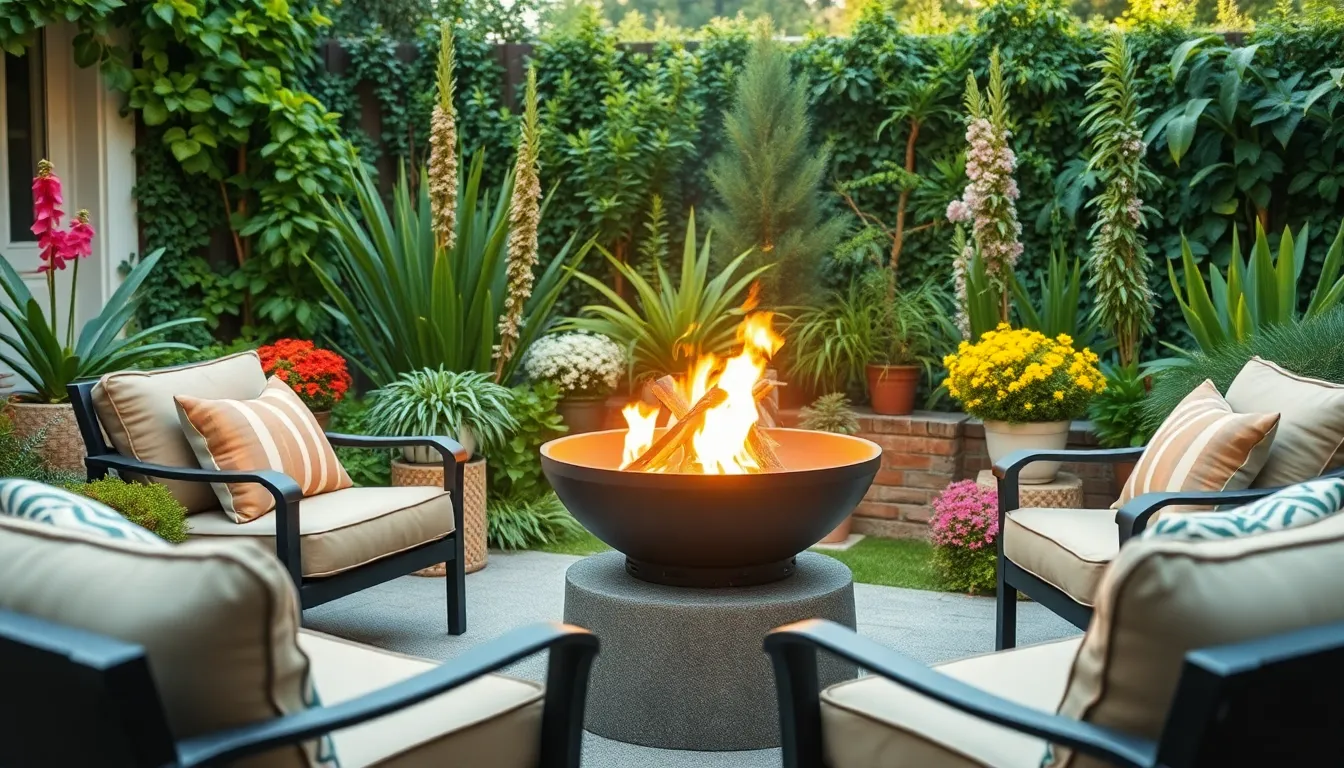
Portable fire pits revolutionize how we approach outdoor entertaining by offering the freedom to adapt our garden layouts based on seasons, occasions, and evolving design preferences. These versatile options provide the warmth and ambiance of permanent installations while maintaining the flexibility to reconfigure our outdoor spaces as needed.
Choose Lightweight Cast Iron or Aluminum Models
Lightweight materials transform our garden fire pit experience by making relocation effortless and practical. Cast iron models deliver exceptional heat retention while remaining manageable for regular movement throughout different garden areas. Aluminum options offer superior portability without sacrificing durability, making them ideal for homeowners who frequently rearrange their outdoor spaces.
We recommend prioritizing fire pits weighing less than 50 pounds for single-person mobility. Cast iron varieties typically weigh between 30-45 pounds, providing the perfect balance of portability and heat distribution. Aluminum models often weigh 15-25 pounds, making them excellent choices for frequent repositioning around patios, decks, and lawn areas.
Weather resistance becomes crucial when selecting lightweight materials for outdoor use. Powder-coated finishes on both cast iron and aluminum protect against rust and corrosion while maintaining their attractive appearance through multiple seasons. Heat-resistant paints ensure these portable units withstand high temperatures without compromising their structural integrity or aesthetic appeal.
Consider Wheeled Options for Easy Movement
Wheeled fire pits eliminate the physical strain of relocating heavy units while protecting our garden surfaces from scratches and damage. Rolling mechanisms allow us to effortlessly move fire pits from storage areas to entertainment zones within minutes. Heavy-duty wheels designed for outdoor use navigate various terrain types including grass, gravel, and paved surfaces.
Ball-bearing wheel systems provide smooth operation and enhanced durability compared to standard plastic wheels. Locking mechanisms on quality wheeled models ensure stability during use while preventing unwanted movement from wind or accidental contact. Removable wheel assemblies on some models offer the flexibility to create either portable or stationary setups based on our exact needs.
Storage convenience increases significantly with wheeled portable fire pits since we can easily relocate them to garages, sheds, or covered areas during harsh weather conditions. This mobility extends the lifespan of our investment while maintaining the pristine appearance of our outdoor entertaining equipment.
Select Designs That Complement Existing Decor
Design coordination creates seamless integration between portable fire pits and our established garden aesthetic. Contemporary gardens benefit from sleek metal designs with clean lines and geometric shapes that echo modern architectural elements. Traditional landscapes pair beautifully with ornate cast iron bowls featuring decorative patterns or nature-inspired motifs.
Color matching ensures our portable fire pit enhances rather than disrupts our existing outdoor color palette. Black and bronze finishes work universally across most garden styles, while copper and weathered steel options add warmth to rustic or industrial-themed spaces. Neutral tones allow us to incorporate seasonal decorations and accessories without creating visual conflicts.
Scale considerations help us select appropriately sized portable fire pits that complement our garden’s proportions and seating arrangements. Smaller 20-24 inch diameter models suit intimate gatherings and compact spaces, while larger 30-36 inch options accommodate bigger groups and open areas. Matching the fire pit’s visual weight to surrounding furniture and industry features creates balanced, harmonious outdoor environments.
Construct a Fire Pit Table for Dual-Purpose Functionality
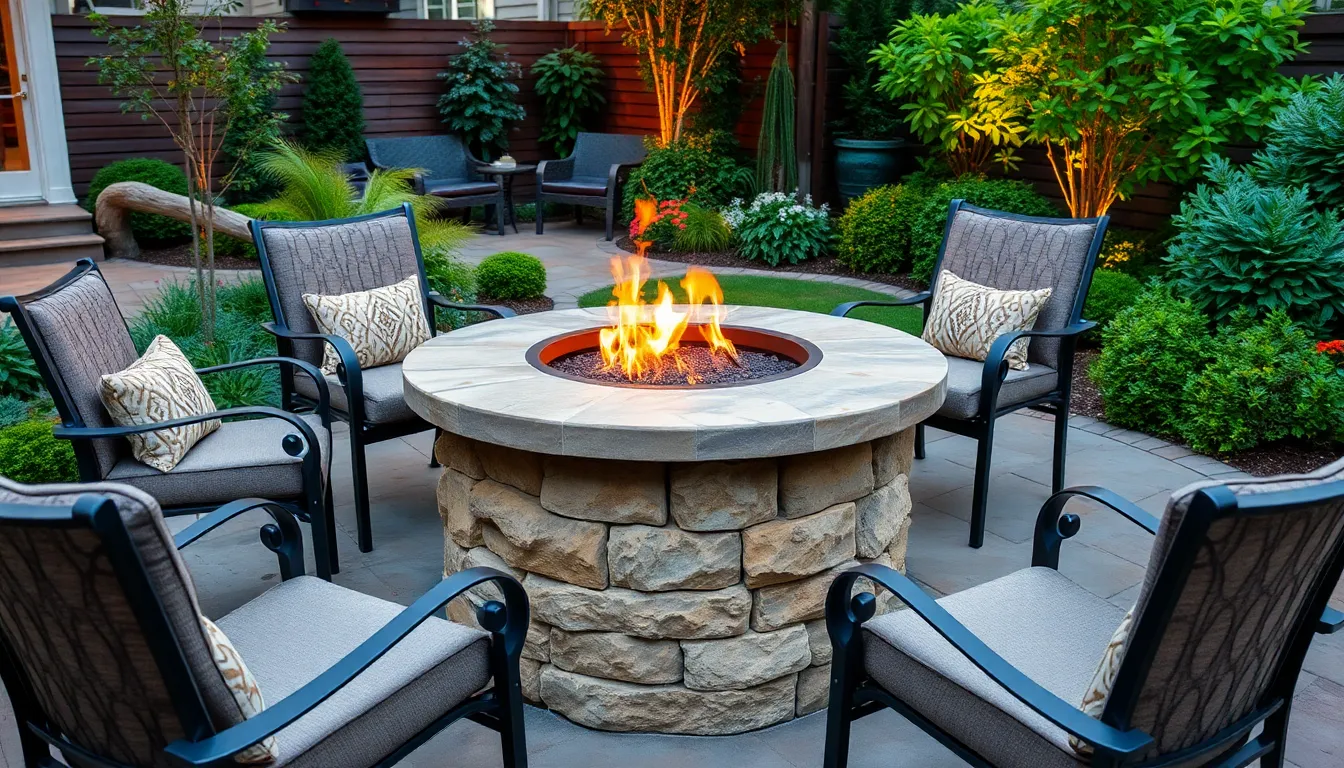
We’ll transform your outdoor entertaining space by creating a fire pit table that serves multiple functions. This design maximizes your garden’s potential while providing both warmth and practical dining answers.
Combine Dining Surface with Central Fire Feature
Designing a fire pit table with dining functionality creates an ideal centerpiece for social gatherings around the fire. We recommend positioning the fire bowl in the center of a rectangular or circular table surface to allow guests comfortable access from all sides. Build the table at standard dining height of 28-30 inches to ensure comfortable seating arrangements while maintaining safe distances from the flames.
Planning the fire feature placement requires careful consideration of proportions and safety clearances. We suggest leaving 12-18 inches of tabletop space around the fire bowl perimeter to provide adequate room for plates, drinks, and dining essentials. Install a removable fire bowl insert that allows you to convert the space into a complete dining surface when not using the fire feature.
Use Heat-Resistant Materials for Tabletop Areas
Selecting appropriate materials ensures both safety and durability for your fire pit table construction. We recommend using natural stone like granite or slate for the tabletop surface, as these materials withstand high temperatures without cracking or discoloration. Concrete offers another excellent option, particularly when reinforced with fiber mesh to prevent thermal expansion damage.
Installing heat-resistant glass tiles creates a modern aesthetic while providing superior thermal protection. We’ve found that tempered glass specifically designed for fire applications maintains its integrity even with direct heat exposure. Metal options like stainless steel work well for contemporary designs, though they require proper insulation underneath to prevent heat transfer to the table structure.
Include Storage Space for Fire Tools and Supplies
Incorporating built-in storage maximizes functionality while keeping essential fire pit accessories organized and accessible. We suggest adding pull-out drawers beneath the dining surface to store fire tools, cooking utensils, and spark guards. Design these compartments with ventilation slots to prevent moisture buildup and ensure proper air circulation.
Creating dedicated firewood storage within the table base eliminates the need for separate wood racks in your garden space. We recommend building open shelving sections with slatted designs that allow airflow around stored wood while maintaining easy access during gatherings. Include weatherproof storage bins for smaller items like fire starters, matches, and cleaning supplies to keep everything needed for fire pit operation in one convenient location.
Design a Fire Pit with Integrated Seating Walls
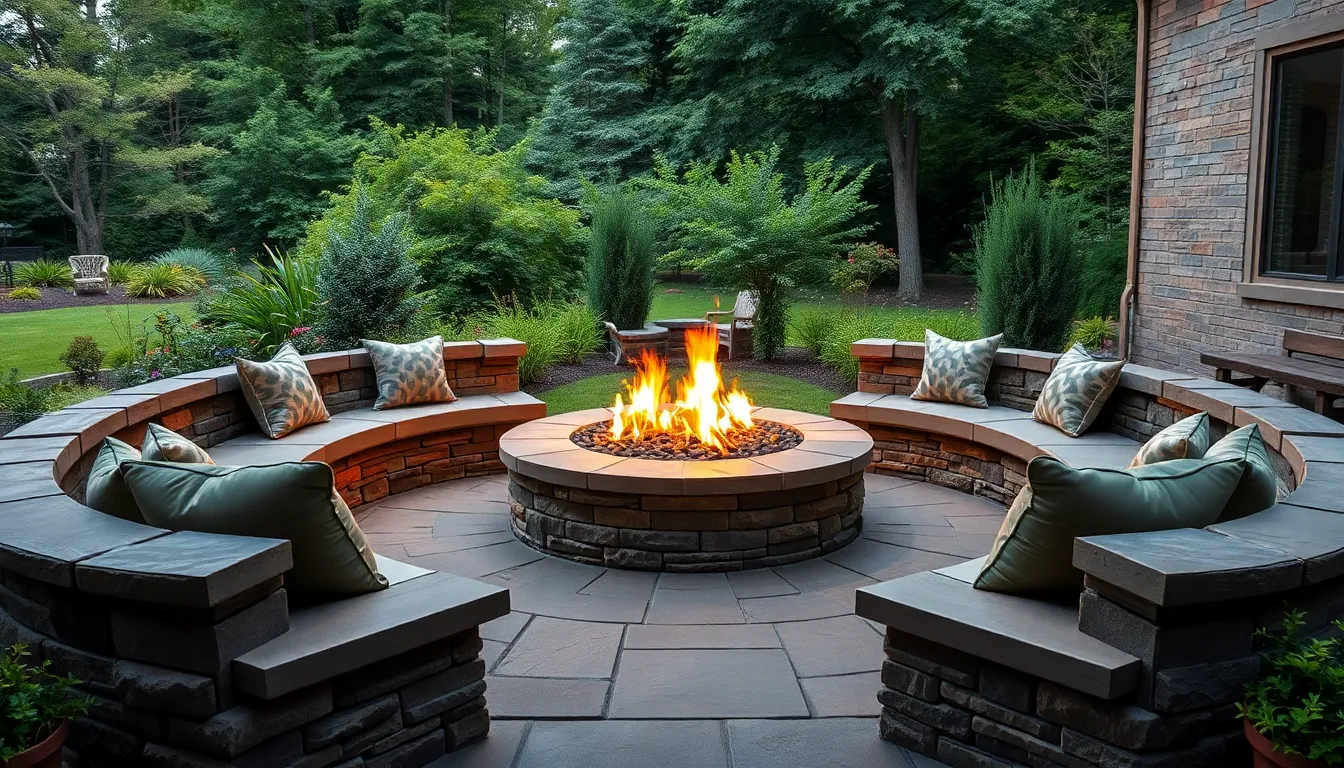
Integrating seating walls directly into your fire pit design creates a permanent gathering space that maximizes both comfort and style. We’ll explore how these built-in answers transform ordinary fire pits into sophisticated outdoor entertainment centers.
Build Curved or Straight Stone Seating Walls
Curved stone seating walls create the most intimate gathering experience around your fire pit. We recommend constructing these walls in a gentle arc that follows the natural circular flow of conversation, encouraging face-to-face interaction among guests. Natural fieldstone or stacked limestone works exceptionally well for curved designs because these materials can be shaped to follow organic lines.
Straight stone seating walls offer a more contemporary approach that complements modern garden designs. We position these linear walls parallel to rectangular fire pits or create geometric patterns that echo your home’s architecture. Concrete blocks or cut stone provide clean edges that enhance the structured appearance of straight wall designs.
Both configurations require a solid foundation of compacted gravel and sand to prevent settling over time. We build these walls between 16 to 18 inches high for optimal seating comfort, ensuring the top surface remains level throughout the construction process.
Maintain Safe Distance from Fire Source
Safe spacing between seating walls and the fire source protects guests while maintaining comfortable warmth levels. We position seating walls at least 3 feet away from the fire pit’s edge to prevent accidental burns and allow safe passage around the area.
Heat distribution varies based on fire pit size and fuel type, so we adjust distances accordingly. Wood-burning fire pits require greater clearance than gas models because they produce unpredictable flame heights and sparks. We test the heat intensity at different distances before finalizing wall placement to ensure comfortable seating temperatures.
Wind patterns in your garden affect how heat and smoke travel, influencing optimal seating wall positioning. We observe prevailing wind directions during different seasons to avoid placing seats directly in smoke paths that could make the area uncomfortable during gatherings.
Add Cushions and Back Support for Comfort
Outdoor cushions transform hard stone surfaces into comfortable seating that rivals indoor furniture. We select weather-resistant fabrics like Sunbrella or marine-grade vinyl that withstand moisture, UV rays, and temperature fluctuations while maintaining their appearance season after season.
Backrest answers significantly improve comfort during extended gatherings around the fire pit. We install removable wooden backs or metal supports that can be stored during harsh weather, or we design permanent stone extensions that provide natural back support integrated into the wall structure.
Storage compartments built into seating walls keep cushions dry and accessible when needed. We create hinged storage boxes within the wall design or designate nearby weatherproof containers that protect cushions from rain and snow while keeping them conveniently close to seating areas.
Create a Fire Pit Kitchen Area for Outdoor Cooking
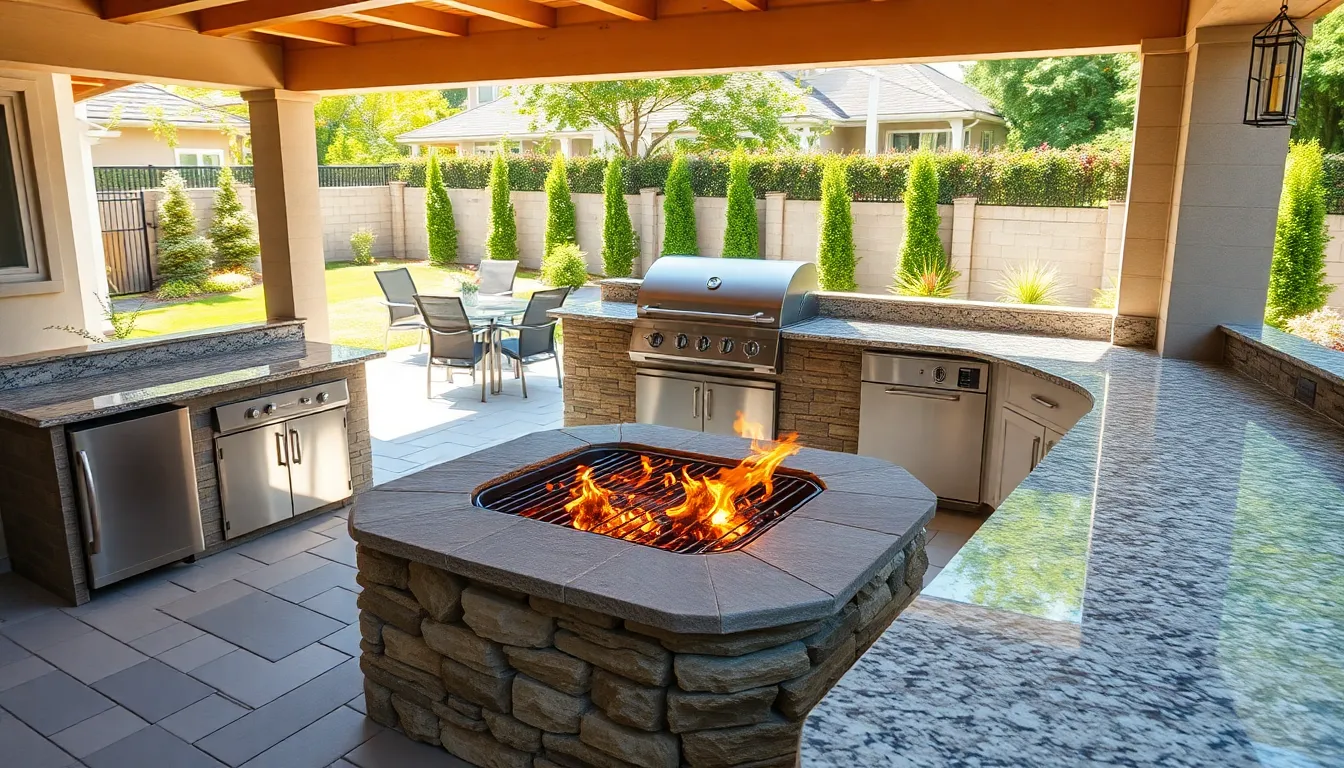
Transform your backyard into the ultimate entertaining space by combining cooking functionality with the warmth of a fire pit. We’ve discovered that integrating materials like Dublin Cobble, Castlemanor Wall, and Weston Stone creates a cohesive outdoor kitchen design that enhances both beauty and practicality.
Install Grill Grates and Cooking Accessories
Installing adjustable grill grates over your fire pit transforms it into a versatile cooking station. We recommend choosing heavy duty steel grates that can handle high temperatures and support various cookware sizes. Position the grates at different heights using adjustable brackets to control cooking temperatures effectively.
Mounting utensil holders directly into stone walls keeps essential tools within easy reach. We suggest incorporating hooks for tongs, spatulas, and grilling forks alongside your fire pit design. Adding swing arm pot hangers allows you to cook stews and soups directly over the flames.
Storage cubbies built into surrounding stonework provide dedicated spaces for cooking accessories. We’ve found that designing pull out drawers beneath prep surfaces keeps seasonings, plates, and serving trays organized. Installing weather resistant covers protects your grill grates and accessories when not in use.
Include Prep Space and Storage Answers
Building dedicated prep surfaces adjacent to your fire pit creates an efficient cooking workflow. We recommend using heat resistant materials like granite or concrete countertops that can withstand outdoor conditions. Position prep areas at standard kitchen counter height (36 inches) for comfortable food preparation.
Incorporating built in storage cabinets beneath countertops maximizes functionality while maintaining clean lines. We suggest adding pull out trash bins and recycling compartments to keep the cooking area tidy. Weather proof cabinet doors protect stored items from moisture and temperature fluctuations.
Creating designated zones for different cooking tasks improves efficiency during meal preparation. We recommend establishing separate areas for raw food prep, cooked food staging, and serving. Adding mini refrigerators or cooler storage keeps ingredients fresh and beverages cold throughout cooking sessions.
Design Proper Ventilation for Smoke Management
Positioning your fire pit kitchen strategically reduces smoke interference during cooking activities. We recommend placing the fire pit at least 10 feet away from seating areas and structures to ensure proper air circulation. Installing overhead ventilation hoods captures smoke and redirects it away from cooking and dining spaces.
Creating natural wind breaks using stone walls or plantings helps control smoke direction without eliminating airflow. We suggest designing curved retaining walls that guide smoke away from frequently used areas. Adding exhaust fans to covered cooking areas ensures smoke doesn’t accumulate under rooflines.
Incorporating multiple air intake points around your fire pit promotes complete combustion and reduces smoke production. We recommend installing adjustable dampers that allow you to control airflow based on wind conditions. Designing proper drainage around the fire pit area prevents water accumulation that can create additional smoke when fires are lit.
Add Water Features Near Your Garden Fire Pit
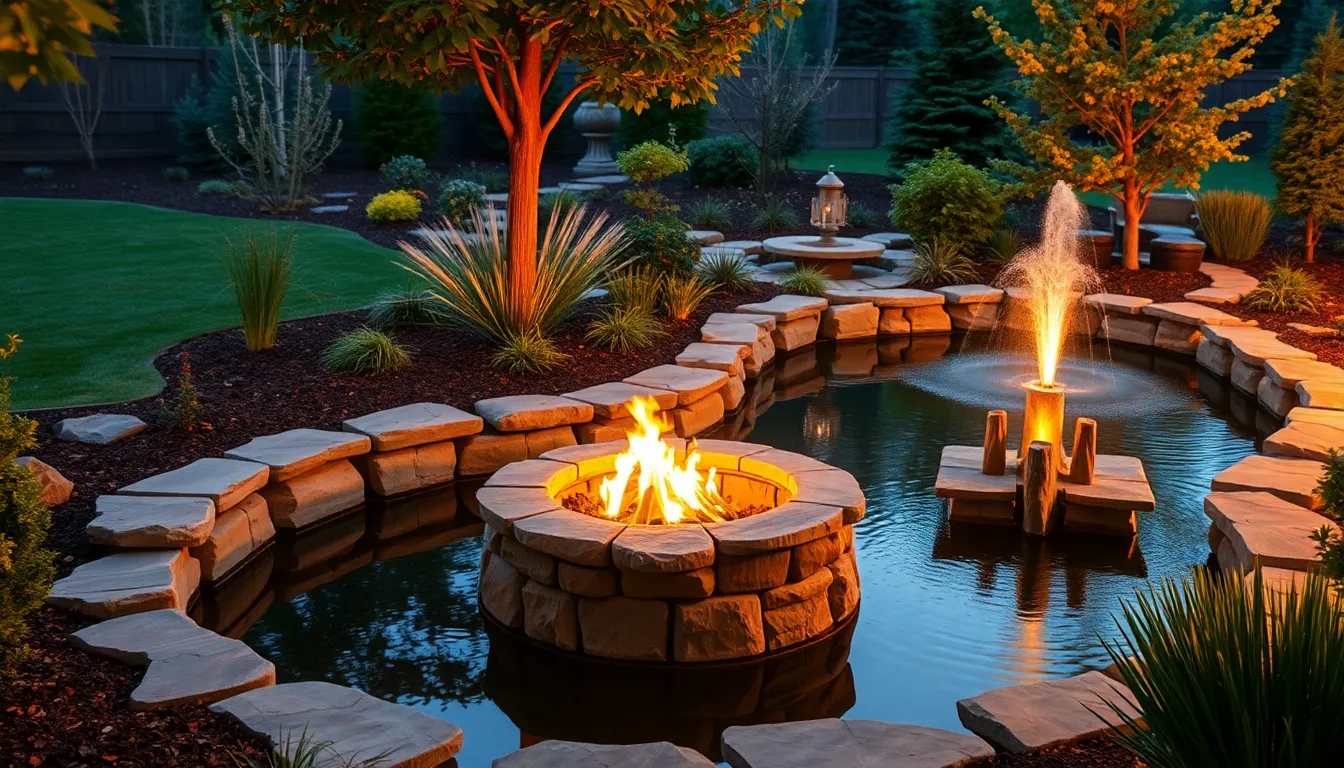
Water elements transform our garden fire pit areas into serene outdoor sanctuaries that engage multiple senses. These complementary features create ever-changing focal points that enhance both visual appeal and ambiance.
Balance Fire Elements with Fountain or Pond Features
Fire and water bowl combinations offer the perfect solution for balancing opposing elements in our outdoor spaces. These integrated designs merge the warmth of crackling flames with the tranquil movement of flowing water, creating a harmonious centerpiece that captivates guests year-round.
Positioning fountains or ponds strategically around our fire pits establishes visual equilibrium while maintaining distinct zones for each element. We recommend placing water features at angles that reflect firelight across the water’s surface, amplifying the magical ambiance during evening gatherings.
Design considerations include selecting materials that complement both features, such as natural stone borders that flow seamlessly between fire and water zones. Scale plays a crucial role in achieving balance—larger fire pits pair beautifully with substantial water features, while intimate fire bowls work best with smaller fountains or decorative water vessels.
Create Soothing Sound Combinations
Crackling fire paired with gentle water sounds produces one of nature’s most relaxing audio experiences. The combination masks urban noise pollution while creating a peaceful atmosphere that encourages conversation and relaxation.
Fountain flow rates directly impact the sound quality we achieve in our fire pit areas. Gentle trickles provide subtle background ambiance, while moderate flows create more pronounced water sounds that compete pleasantly with fire crackles.
We’ve found that positioning water features upwind from seating areas helps carry soothing sounds toward guests without overwhelming the fire’s natural acoustics. This strategic placement ensures both elements contribute to the overall sensory experience without one dominating the other.
Ensure Safe Separation Between Fire and Water
Safety requires maintaining adequate distances between fire sources and water features to prevent dangerous interactions. We recommend minimum separations of 6-8 feet between active flames and water elements to avoid steam generation or thermal shock to materials.
Electrical components in water features need extra protection when positioned near fire pits. Ground fault circuit interrupters become essential safety features, and we always route electrical lines away from heat sources using appropriate conduit protection.
Professional installation ensures proper safety measures while maximizing the aesthetic potential of combined fire and water designs. Licensed contractors understand local codes and can integrate utilities safely, protecting our investment while creating stunning outdoor environments that impress neighbors and provide years of enjoyment.
Incorporate Lighting Around Your Fire Pit Space
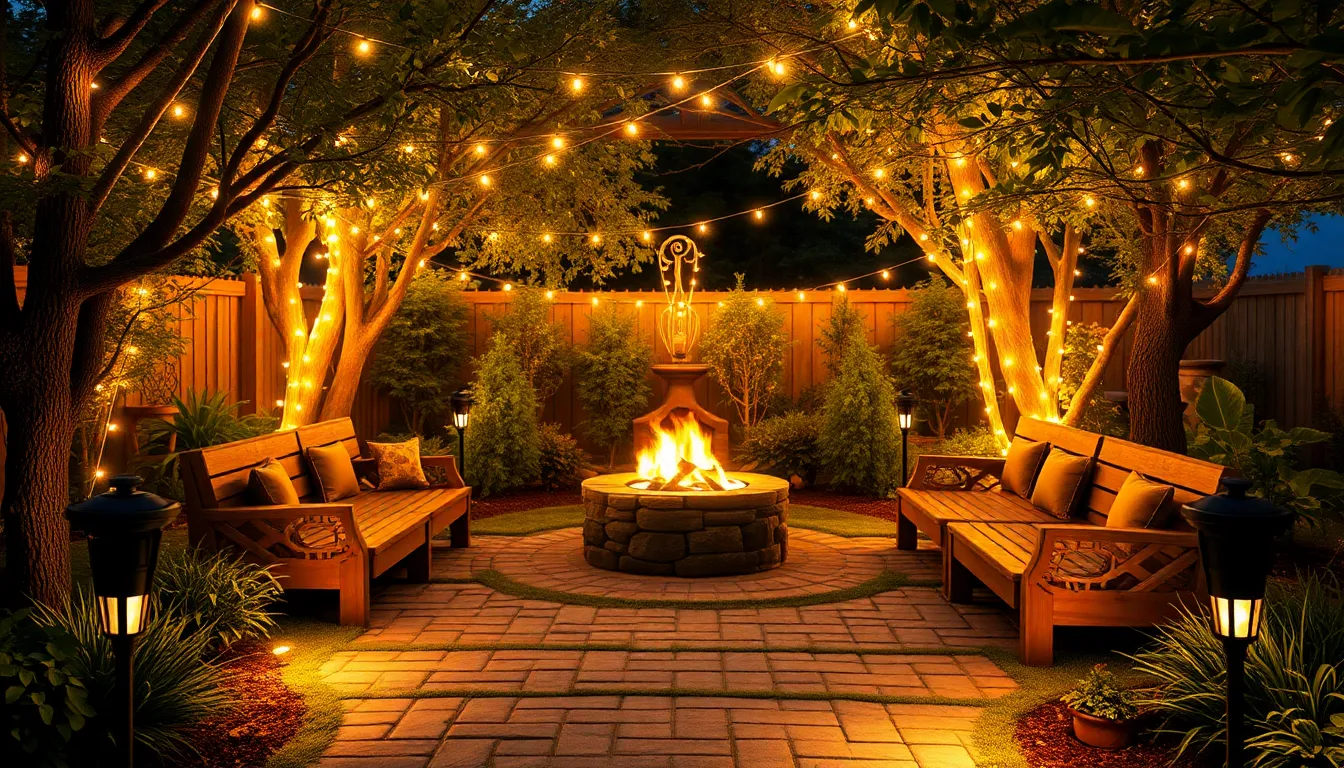
Strategic lighting transforms our garden fire pit areas into enchanting evening retreats that extend usability well beyond sunset. Well-planned illumination enhances both safety and ambiance while creating dramatic visual effects around our outdoor gathering spaces.
Install Solar or LED Path Lighting
Solar path lights provide safe passage to and from our fire pit areas while highlighting key garden features along the way. LED fixtures offer consistent illumination throughout the evening without requiring electrical connections or ongoing energy costs. We recommend spacing these lights every 6-8 feet along walkways to create smooth transitions between our home and outdoor entertaining space.
Ground-level lighting fixtures prevent tripping hazards while directing guests toward seating areas around the fire pit. Solar models automatically activate at dusk and provide 8-10 hours of continuous operation after full daylight charging. LED path lights deliver brighter output and longer lifespans compared to traditional solar options, making them ideal for frequently used fire pit pathways.
Add String Lights for Ambient Atmosphere
String lights create magical twinkling effects that enhance the cozy ambiance around our fire pit spaces. Warm white LED bulbs produce the most flattering glow while maintaining energy efficiency throughout extended evening gatherings. We suggest installing these lights between nearby trees, pergola posts, or dedicated light poles to create overhead canopies of soft illumination.
Edison-style string lights complement rustic fire pit designs while maintaining vintage charm that pairs beautifully with natural stone and wood elements. Weatherproof connectors ensure reliable operation during outdoor conditions, and timer controls allow us to preset lighting schedules for consistent evening ambiance. Multiple string levels at varying heights add depth and visual interest to our fire pit lighting design.
Include Safety Lighting for Evening Use
Safety lighting ensures visibility around fire pit perimeters and prevents accidents during evening gatherings. Motion-activated fixtures provide hands-free illumination when we’re adding firewood or adjusting fire pit controls after dark. We recommend installing these lights at key points around seating areas and fuel storage locations for optimal safety coverage.
Low-voltage industry lighting offers permanent safety answers without the harsh glare that disrupts intimate fire pit atmospheres. Bollard lights positioned near seating walls provide subtle ground-level illumination while maintaining the cozy evening ambiance we desire. Emergency lighting systems with battery backup ensure continued visibility even during power outages, keeping our guests safe throughout any outdoor gathering.
Choose Fire-Resistant Plants for Fire Pit Landscaping
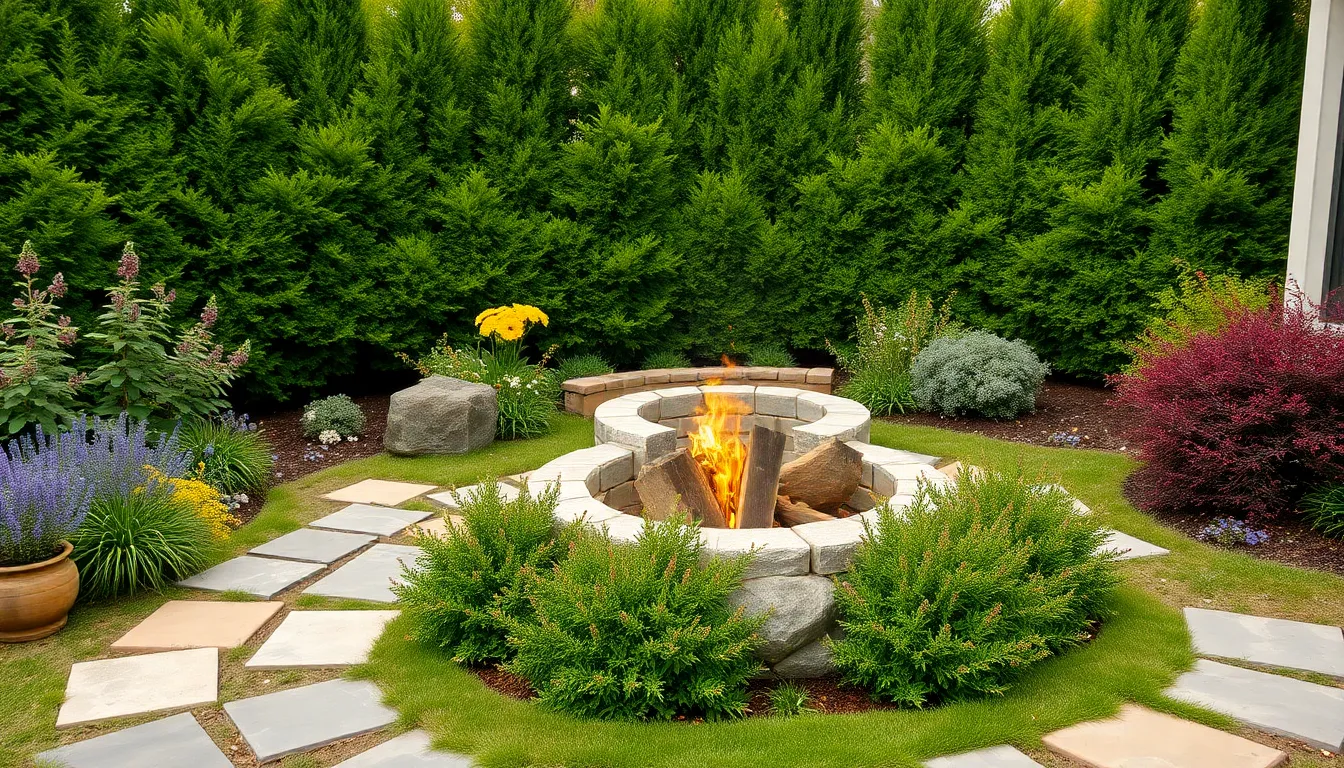
Creating a safe garden fire pit area requires thoughtful plant selection that balances beauty with fire safety. We’ll explore strategic landscaping choices that protect your outdoor space while maintaining stunning visual appeal.
Select Native Drought-Tolerant Plant Varieties
Native drought-tolerant plants reduce wildfire risk while requiring minimal irrigation throughout growing seasons. Buffalograss (Buchloe dactyloides) provides excellent ground cover with deep root systems that naturally adapt to local climate conditions. Southwest native sedums offer colorful, low-maintenance options that thrive in dry conditions without compromising fire safety.
Fire-resistant shrubs like bluebeard (Caryopteris x clandonensis) and burning bush (Euonymus alatus) feature high moisture content and minimal volatile oils. Honeysuckle (Lonicera), lilac (Syringa), and red-twig dogwood (Cornus sericea) create beautiful borders while maintaining natural fire resistance through their plant structure.
Succulents excel in fire pit landscaping due to their exceptional moisture retention and ignition resistance. Various ice plants (Delosperma) spread quickly across garden beds, while sedums provide diverse textures and colors. Native manzanita (Arctostaphylos) adds height and structure to drought-resistant plant arrangements.
Maintain Proper Clearance from Fire Source
Establishing a bare ground or noncombustible surface area around your fire pit prevents flame spread to surrounding vegetation. Fire safety codes recommend maintaining a minimum 5-foot clearance zone using materials like gravel, stone, or concrete pavers. This safety buffer protects both your landscaping and guests from potential fire hazards.
Regular maintenance removes dead leaves, branches, and debris from the immediate fire pit vicinity. Weekly inspections during dry seasons help identify potential fire hazards before they become dangerous. Trimming overhanging branches and removing accumulated organic matter keeps your clearance zone properly maintained.
Stone or concrete surfaces within the clearance zone provide both safety and aesthetic appeal. Decorative pavers create defined pathways while maintaining fire-resistant ground cover. Heat-resistant materials ensure your safety zone remains functional and attractive throughout all seasons.
Create Natural Windbreaks and Privacy Screens
Strategic shrub and tree placement reduces wind speed while containing embers within your fire pit area. Rhododendron and red-twig dogwood serve dual purposes as effective windbreaks and attractive industry features. Positioning these fire-resistant species upwind from your fire pit creates natural barriers against wind-blown sparks.
Dense, fire-resistant evergreen shrubs provide privacy without compromising safety standards. Avoiding fine-needled, resinous evergreens like pines and junipers prevents highly flammable materials near fire sources. Layering plants with different heights and textures increases both privacy and fire resistance while creating visual interest.
Natural privacy screens using fire-resistant plants maintain open sight lines for safety monitoring. Multiple plant layers create effective visual barriers while allowing air circulation around fire pit areas. Combining low shrubs with medium-height bushes provides graduated privacy without creating fire hazards.
Conclusion
We’ve explored countless ways to transform your outdoor space with fire pit designs that suit every style and budget. From rustic stone circles to sleek modern bowls these ideas offer something for everyone looking to enhance their garden’s appeal.
The key lies in choosing features that match your lifestyle and space requirements. Whether you prefer portable options for flexibility or permanent installations with integrated seating your fire pit can become the heart of outdoor entertainment.
Remember to prioritize safety through proper plant selection fire-resistant materials and adequate lighting. These elements ensure your fire pit area remains both beautiful and secure for years of memorable gatherings.
Start planning your dream fire pit today and create an outdoor sanctuary that’ll have your neighbors asking for design tips. Your perfect backyard retreat is just one project away.
Frequently Asked Questions
What materials work best for building a stone circle fire pit?
Natural materials like fieldstone and river rock are ideal for stone circle fire pits. These materials offer excellent heat resistance, durability, and rustic aesthetic appeal. They also provide good insulation and help maintain structural integrity over time. Always ensure proper drainage with a gravel base and focus on creating stable, level foundations for optimal performance.
How do I choose the right size for my garden fire pit?
Select a fire pit size based on your available space and typical gathering size. Allow at least 10 feet of clearance around the fire pit for safety. Consider your seating arrangements and ensure the fire pit is proportional to your outdoor space – too large can overwhelm small gardens, while too small may not provide adequate warmth for larger areas.
What safety precautions should I take when installing a fire pit?
Maintain proper clearance distances from structures, trees, and combustible materials. Install fire pits on level, non-combustible surfaces like concrete or stone pads. Ensure adequate ventilation and consider wind patterns. Always check local fire codes and obtain necessary permits. Keep fire extinguishing materials nearby and never leave fires unattended.
Are portable fire pits as effective as permanent installations?
Portable fire pits offer excellent flexibility and can be quite effective for smaller gatherings. While they may not provide the same heat output as larger permanent installations, they’re perfect for seasonal use and smaller spaces. Choose models with weather-resistant materials like cast iron or aluminum, and consider wheeled options for easy relocation.
What plants are safe to grow near fire pits?
Choose fire-resistant, drought-tolerant plants with high moisture content. Native varieties like Buffalograss, Southwest sedums, bluebeard, and burning bush are excellent choices. Maintain a clearance zone of at least 10 feet around the fire pit using noncombustible materials. Avoid dry, resinous plants that could easily ignite.
How can I incorporate seating into my fire pit design?
Built-in stone seating walls create permanent, weather-resistant options that complement your fire pit design. Maintain safe distances from flames while ensuring guests can feel the warmth. Add outdoor cushions and back support for comfort, using weather-resistant materials. Consider curved designs for better conversation flow and social interaction.
What lighting options work best around fire pit areas?
Combine multiple lighting types for optimal safety and ambiance. Install solar or LED path lighting for safe navigation, string lights for cozy atmosphere, and motion-activated safety fixtures around the perimeter. Low-voltage landscape lighting provides subtle illumination without overwhelming the natural fire glow. Well-planned lighting extends usability beyond sunset.
Can I combine a fire pit with cooking functionality?
Yes, fire pit kitchen areas offer excellent dual functionality. Install adjustable grill grates, utensil holders, and storage cubbies for cooking accessories. Use heat-resistant materials like granite or slate for prep surfaces. Ensure proper ventilation for smoke management and consider wind direction when positioning cooking elements.

